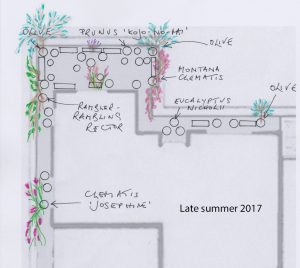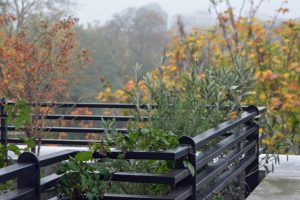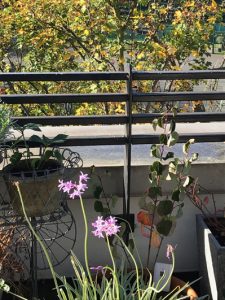Early Ambitions
I have memories, faint like the drawings themselves, of looking at plans, perhaps of Versailles, perhaps of palaces and places nearer home, with painstaking details marked in now fading ink, of long canals and formal planting stretching out into the countryside beyond. It is often the gardens, rather then the historical contents that have stayed in my mind from these visits, but nowadays I am happy to settle for wandering around gardens of any size without a sense of obligation to go indoors.
Many of my larger pots and containers have travelled from place to place as I have, and some of the smaller ones too, but this roof-top project is relatively new and I was joined by the plants as my move became more settled. I began with great ambitions, drawing up plans which included larger new containers drawn to scale. So far so good. But somehow in my early enthusiasm, and a wish born of desperation to mask the starkness of the parapet walls and much else besides, I overlooked the importance of paying attention to plant growth and ultimate size. Even in a container most things grow and for a while quite happily. Easily swayed I drew up elaborate plans for this elevated plot, as in need of some structure myself, and lacking modesty, I drew and sketched the structures and plant life I wanted around me. These included a pond, albeit a pond in a container.
The structures remain, some sturdy rectangular planters functioning as miniature raised beds, with an assortment of new and old tubs, containers, pebbles, garden furniture and other garden paraphernalia, but the planting plan has gradually been relinquished in favour of fewer favourites with less need of space and a bit more attention to wildlife.

Nevertheless, with the Autumn clear up more or less over, what seems to be emerging is something more like a set design than a garden in waiting. The exuberance of the earlier months has gone leaving behind a particularly tidy terrace – I’m not sure I like it but I’m not sure there’s an alternative. True there remains a selection of well placed pots with silvery evergreen foliage – including the aforementioned Eucalyptus nicholii doing well, olives hopefully undaunted by my pruning but which will never amount to the beauty and productivity of a Greek olive grove, lavenders, rosemary and yet more premature hellebores. But as skeletal shapes and pots of bare compost emerge, all I can do now is wait for the plants to take over next year and plan for more.
Learning from Experience
Meanwhile with the departure of the summer beauties my resolve to keep new plants to a minimum has gone too. I have succumbed, and with the help of tried and tested suggestions, I have bought a Prunus incisa ‘kojo-no-mai’ waiting for a new container (it grows very slowly, only reaching 1.2 metres in 10 years, so I would argue justifies a home to match it’s seasonal beauty), ordered Anemone ‘wild swan’ and some sweet box, as I couldn’t find either locally, and my spring bulbs are waiting to be planted. With bulbs as with everything there are choices to be made and I am biased towards showy, long lasting tulips for maximum impact where space is limited. They will have to wait a bit longer to be planted as it is sunny and warm at the moment and tulips I know do better after a snap of cold weather to kill off any virus.
I’m now toying with the idea of a crab apple. To think of it as a tilt in the direction of an orchard would be absurd but I can provide a sunny spot for a container-happy variety and it will give white flowers in the Spring. More immediately some pots have to be moved aside for the window cleaners, expected shortly. They are carelessly happy to walk along the waist high balustrade to reach the less accessible windows, but watching them makes me anxious, and angry, so I try to create a temporary path through the foliage and larger plants. This however, is ignored as they jump across the balustrade above a 100 foot drop with evident bravado as precarious as the route they have chosen. This is another reminder that I have come rather late to the idea that gardening involves planning and planning ahead, as window cleaners, as well as water, were far from my mind in my initial thoughts for this space, other than of course the over ambitious pond.

I do now have a watering system, thanks to a generous neighbour, but in the early days I relied on a watering can, hanging out of windows and walking along narrow door sills. One day I slewed a full can of (luckily) clean water over a new carpet, so my neighbour’s offer shortly afterwards could not have come at a better time. However, having attached a hose with a long lance to my new watering system, with an excess of enthusiasm one of my first attempts at long range watering went horribly wrong as I hadn’t closed the doors leading on to the walkway from another direction – luckily the books dried and the old wooden chest recovered too but I’m now more careful. I’ve also learned that narrow walkways need tall plants if they are to be easily visible through waist high windows. I now combine watering with wondering, in reality in all seasons, as the wind dries the pots and the rain seldom penetrates in all but the heaviest of downpours.
An early decision (and maybe poor planning) was to remove the sole piece of trellis purchased with the property. Prematurely maybe, as it never occurred to me I might need it since vines or even hops were not in the scheme. However, I now see, and thought then, that although it was providing an effective barrier between the terrace and the northerly wind, it obscured too much. The glimpse of the hills to the northwest has been well worth keeping even at the cost of a good vintage. I have however, conceded that bamboo has its uses and with mixed feelings recently filled a gap in the ‘wind-break’ with a pot of Nandina domestica. A rose by any other name……. whatever it is called, it is a bamboo. Also unplanned was an answer to the question of what to do with leaf litter and the other detritus from my container gardening. Luckily the terrace and walkways all have an array of gravel and pebbles of various sizes around the edges to aid drainage. The flow is generally towards the down-pipes, although not universally successfully, but the margin on the upslope provides the ideal destination for my sweepings and a good enough habitat, particularly for woodlice.
Perhaps I will discover more about insects and how to encourage them (fashionable bee hotels being constrained by my concern to avoid drilling into the ‘common parts’) at a forthcoming local event https://goo.gl/6riyfw when I will be accompanied by a particularly knowledgeable and enthusiastic seven year old.

Although writing reminds me of what I don’t know I am surprised and pleased that I do know something and am beginning to learn more. My roof top preoccupations can’t be compared with proper gardens and gardening but it is encouraging that some experiences are obviously transferable. Now knowing that standard lavenders have a mind of their own I am spurred on to find an answer to the problem of keeping them upright and wonder if a table leg might be the support I’m looking for. Perhaps not so easily available in open ground but solid, adjacent to the wall, just about visible from indoors looking out, and in a relatively sheltered situation I will try again, but not with a pair. Actually not with one of the original two either http://retiringgardener.uk/2017/10/08/trials-and-tribulations/as impatience took over and I wrenched out the lavenders on a particularly windy day, frustrated by the undoing of my plans. Instead I have two Cercidiphyllum japonicum ‘red fox’. These caught my eye on a visit to a local garden centre, when tasked to search out and shop on behalf of the allotment, I drifted towards some interesting foliage. Not surprising that they caught my eye as the vivid Autumn colour is spectacular and another claim to fame is their upright growth. They will never be a formal matched pair, but hopefully will be an interesting, new, rather expensive, discovery.
With the days getting noticeably shorter, returning to city life towards the end of summer, leaving behind golden fields and generous gardens, has always been hard. In Spring and Autumn the differences between the two worlds seem bridgeable as cities and the countryside come into leaf, with blossom and new growth having a visible impact, often in sequence, in these different settings. High summer is very different – urban spaces, however large, lose out. However, whether in suburban gardens or country meadows unseasonal colour is a welcome delight.
An anemone in September a few miles away, or a cowslip in October in Oxfordshire, are unexpected. Even more surprising, at least to me, is the extended flowering, disregarding the seasons, of this balcony favourite. Still magnificent, and promising more, I think it must be an allium. I’ve thought of dividing it, promising half to a friend, but it’s name eludes me. Another friend can identity it but as he came at the height of my agitation about the leak, sadly I can’t now remember what he told me. I will ask again.
promising half to a friend, but it’s name eludes me. Another friend can identity it but as he came at the height of my agitation about the leak, sadly I can’t now remember what he told me. I will ask again.
Thinking too now, I also wonder whether gardening at the level of individual plants is really gardening at all or is it toying, Marie Antoinette like, avoiding the harder tasks and the worst of the weather, planting pretty plants to be enjoyed by a few visiting pollinators and intimate friends. It doesn’t deter me but it makes me think. The feeding birds can usually be counted on the fingers of one hand and a pond in a pot would never have been colonised by frogs, so beyond buying bird food and retaining some leaf litter there must be more ingenious ways to attract other visitors. Hopefully I will pick up some ideas from the local Pollinators Paths Project.
Looking Ahead
More immediately, phase two of the leak/balcony repairs are planned for next week, with the erection of scaffolding towers, and the return of the workforce. I’m hoping to make the most of their presence as a third olive is growing fast and needs to be moved, actually to be almost directly above the soon to be permanently repaired leak, where it will have plenty of elbow room. Better planning would have been to have put it there in the first place but a swap with the more elegant eucalyptus should be fine, although I do need help to move it. I had thought the olive would take longer to get established but I was wrong. I thought the eucalyptus would need more space. Wrong again. It has an elegant neck, or trunk, and needs space higher up as it’s branches unfold.

Whatever, I am spurred on by much that is going on around me – plans to refresh the gardens below, the evident happiness of my clematises and roses, news that a simpler plan may mean phase three of the balcony repairs could be less disruptive and the determination of so many of my summer plants, including pelargoniums and clematises, to stay in flower. Although the former may have to be ousted when it comes to bulb planting, which is a pity, particularly as I lack a conservatory or cool kitchen to move them on to. I had also been hoping to find a Chinese Bee Tree, Tetradrium daniellii, recommended for its generous supplies for foraging bees, and another potential new arrival. But, I have now learned my lesson and so check the ultimate height and spread of anything unfamiliar and as it aims to reach a height of twelve metres or over I have reluctantly relinquished this idea.





